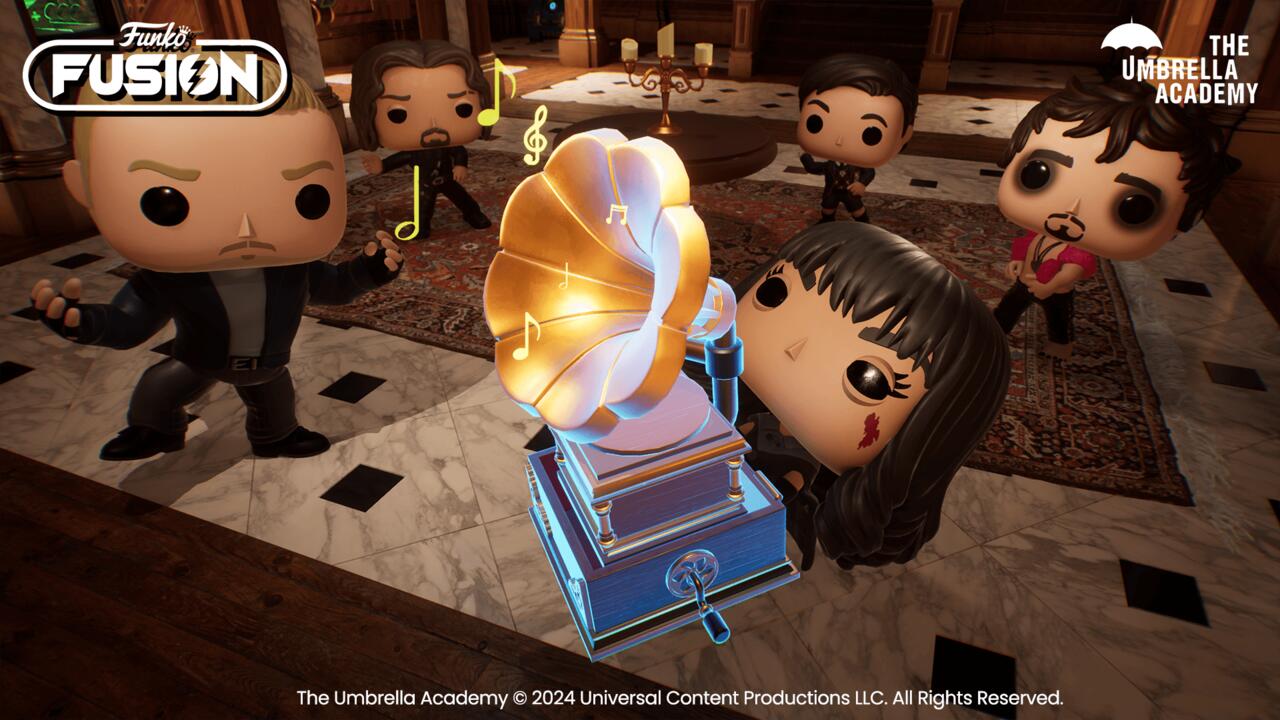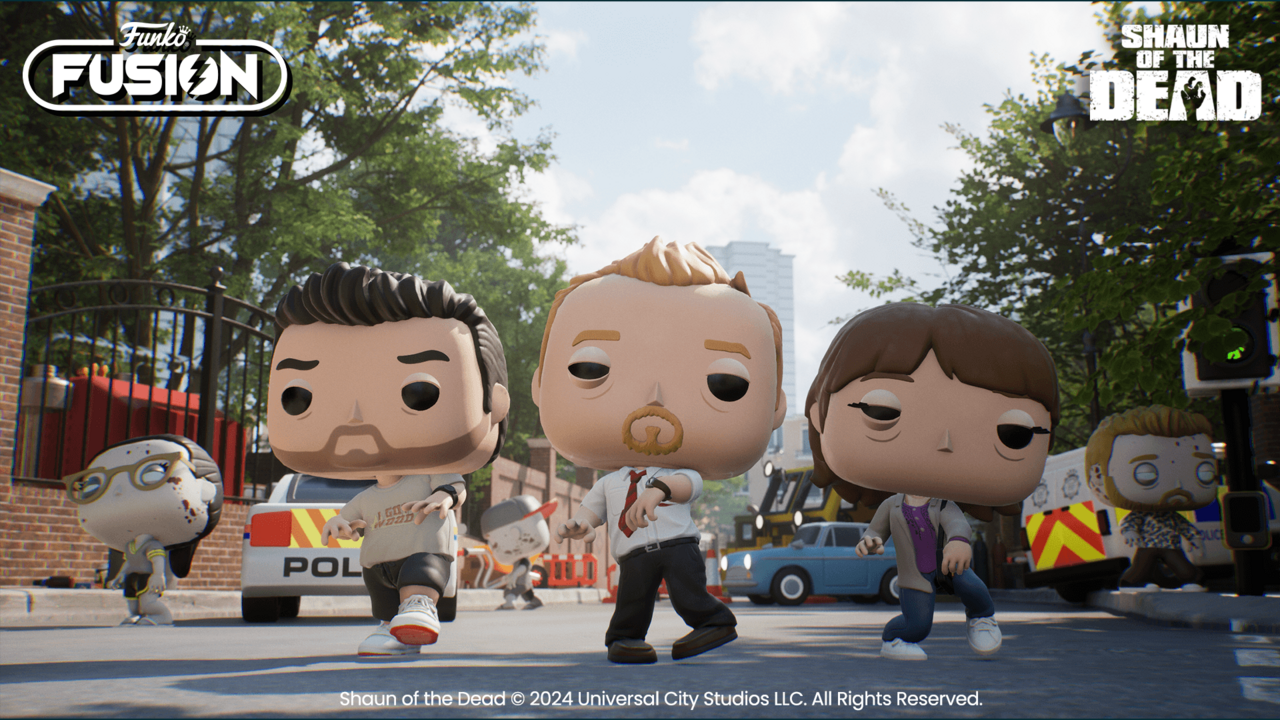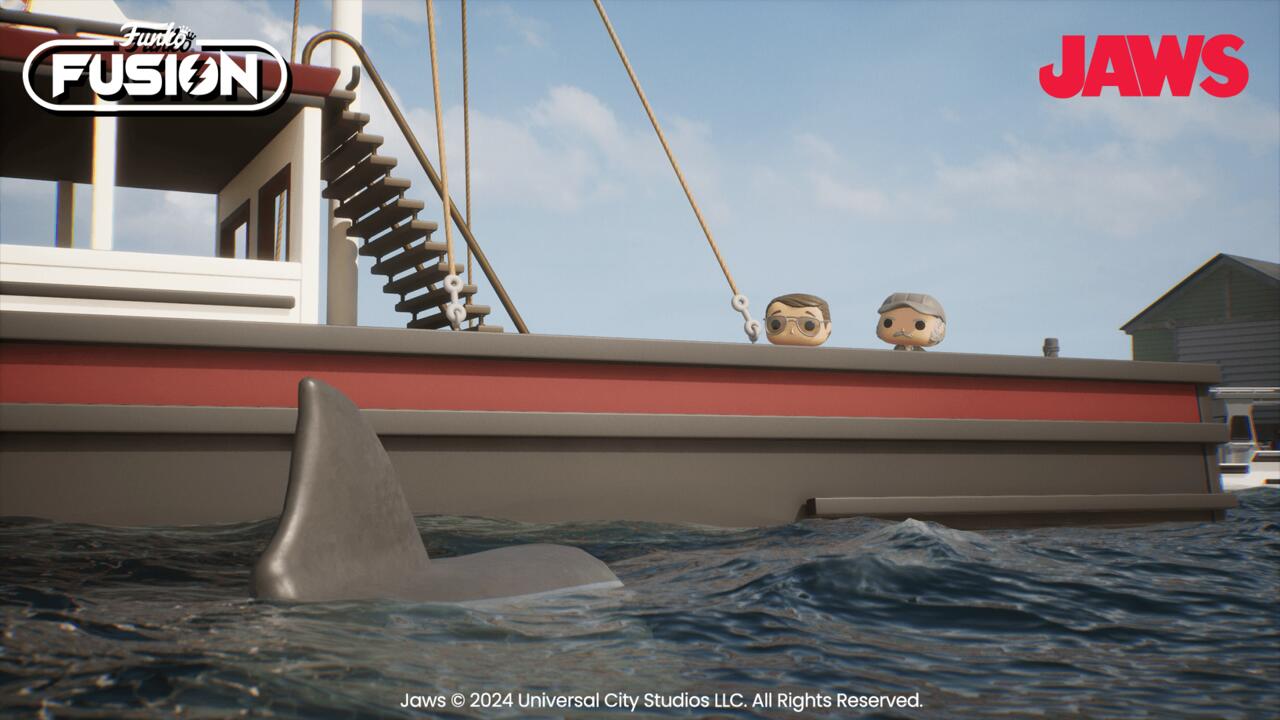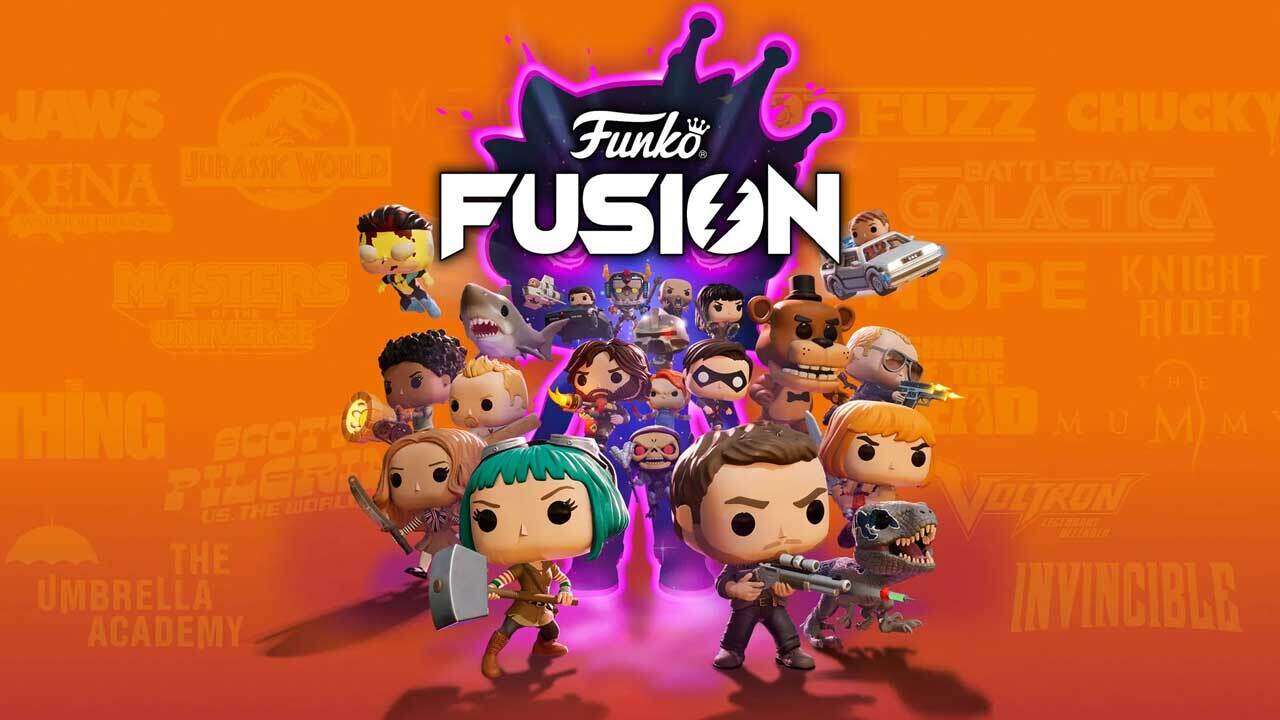You could argue the current media landscape’s obsession with crossovers, mash-ups, and hearty stews of intellectual property began with Funko Pop, collectible vinyl figures that have been popular for many years now and are made to resemble just about anything from pop culture–from rockstars and Star Trek villains, to cereal mascots and retired athletes. Before Fortnite became something like a Funko Pop game in its own way, Funko Pop figures were decorating mall stores and collectors’ shelves with fan favorites and deep cuts. In retrospect, it’s surprising we didn’t get a Funko Pop console and PC game until now, though given the state of Funko Fusion, we would have been better off continuing to wait.
Presented in an over-the-(tiny)-shoulder third-person view akin to Lego Star Wars’ latest effort, Funko Fusion similarly has you running around colorful worlds inspired by movies and TV shows you may already enjoy. Whereas the Lego games tend to pull from the tip-top of the popularity stack and adapt things like Marvel and Lord of the Rings, Funko Fusion takes on a fascinatingly strange assortment of series.
The biggest of them, Jurassic World, fits well in that aforementioned top tier. Beyond that, however, you’ll find hub worlds, levels, and characters inspired by unexpected and smaller properties, with the full list of main attractions including Scott Pilgrim, Hot Fuzz, The Thing, Masters of the Universe, The Umbrella Academy, and Battlestar Galactica (the 1978 version). This list reads like the involved IP were all chosen randomly, but in actuality, it’s because they share a common distributor: Universal Studios.
Each world unfolds much like a Lego game. You’ll drop into a 3D level full of objects to smash and bad guys to pummel or shoot at, solving puzzles to advance between the regular attacks from villains. The music and scenery change for each property in fun ways–an early Scott Pilgrim level uses the movie’s soundtrack, for example, which I haven’t heard since it debuted years ago but immediately recognized as being from the Michael Cera-led adaptation. This was an even more exciting feature when I got to The Thing levels, where the silly vinyl statues were made just a bit creepier thanks to the film’s unnerving music amplifying the foreboding nature of the surrounding snowy hellscape. Of course, using the music from each property is to be expected, but while it wasn’t surprising, it was immersive anyway.
Despite wearing its Lego inspiration on its sleeve, Funko Fusion is not really for kids. That’s apparent in a few ways–like The Thing being involved at all, or how Scott Pilgrim’s band, Sex Bob-Omb, is prominently featured in the run of levels set in the Edgar Wright movie’s universe. But it’s more obviously not for younger players in ways that ultimately make it worse, even for its intended audience. Unlike the Lego series, which followed a formula honed over dozens of games across nearly 20 years, Funko Fusion fails to stick to its internal logic when it comes to level and puzzle design, and quickly becomes frustrating and confusing as a result.
The Lego games were famous for their light puzzle elements, which the team at TT Games call “nuzzles,” short for “not puzzles.” Designed to make players stumble only briefly while skillfully pointing them to the solution with on-screen hints like rattling bricks or sparkling terminals, there is an art to how a Lego game level unfolds. An adult-oriented game that adapted the Lego games’ take on puzzles and just made them tougher could have worked, but that’s not what Funko Fusion is, in large part because its levels rarely make visual sense. When I played a portion of Funko Fusion earlier this year, I figured my confusion around some of the game’s puzzle mechanics was due to having missed a tutorial section that would be in the full game and explain away issues I had. As it turns out, no such tutorial exists, which commonly left me confused about how to proceed. Funko Fusion’s level design doesn’t provide enough direction to maintain an enjoyable sense of progress.
This issue is exacerbated by the way Funko Fusion fails to telegraph which parts of its levels are meant for now and which aspects are meant to be revisited on replays after more items or characters have been unlocked. An early level in my playthrough featured yellow arrows painted in front of a locked door. I’d never seen them before, and to that point in my playthrough, I hadn’t noticed anything that was gated off to me. I learned only much later, while playing The Umbrella Academy levels, that a particular character in that world can phase through the wall if they stand on those arrows and perform a dash.

In the moment, I fidgeted with the environment for a few frustrating minutes, trying to determine what I was meant to do, when really the answer was simply “come back later.” The game doesn’t tell you this in any way–not via a tutorial and not with easily understood in-level hints. You’re left to guess and troubleshoot, which sometimes led me to give up on puzzles I later realized actually were doable, but the inconsistent visual language of the game had me dizzy and questioning my efforts throughout many of its 30+ levels.
Funko Fusion doesn’t benefit from years of first-hand practice like TT Games’ series does, but it seems to clearly look to the Lego games closely, so it’s a bit baffling that the level and puzzle design ignore some of the vital qualities that make those games so enjoyable. It captures the broad strokes of a Lego game but misses many of the nuanced strengths of that series. It may benefit from being distinct from its contemporaries and not being as formulaic as the Lego series became over 20 years, but Funko Fusion swaps out a recognizable and beloved formula for irritating chaos driven by poor in-game signposting.
Other puzzles are similarly frustrating, though sometimes for different reasons. A recurring type is a locked chest full of loot, such as limited-use superweapons and health kits, that can only be opened if you pull on four levers before a timer expires. You can do this in a few ways, such as running the optimal route to get them all in time, or using a faster character or drinking a speed-boosting soda you may have found. But some examples of this puzzle seemingly can’t be done if you have neither the consumable nor an appropriate character. Still, because earlier puzzles of the same nature could be handled with a bit of extra ingenuity, I wasted time trying to see what I was missing, rather than quickly determining I just wasn’t equipped with the right tools yet. The game routinely introduces a concept, then changes it without telling you, making puzzles more like a lockbox without a key than a Rubik’s Cube.
That problem cascades even further due to shoddy, often frustrating combat. Shooting doesn’t feel accurate, and strangely cranking up the aim assist to try to solve that problem seemingly didn’t change anything, or if it did, it was too subtle for me to notice. Melee is reliable enough–just get in close and mash the punch button–but I experienced a range of complications with this. Enemies sometimes corner-trapped me, and infinitely-spawning enemies would undermine puzzles by getting in my way and reducing the timing windows of some solutions. There were some mini-boss encounters that, like the puzzles, have to be figured out with in-the-moment trial-and-error, rather than the levels leading up to them acting as a tutorial to prep me or expressive visual language guiding me toward the solution during the fight.

There’s one recurring mini-boss type who sponges a ton of damage before finally being made to dizzily walk toward a circle on the ground, but what to do after that was lost on me for a while. Eventually, I realized that if I looked high above them, I could send a chandelier crashing down by shooting it. This put them in a similarly groggy state, but one that demanded a different tactic, as it left them open to melee attacks. While the initial realization introduced a bit of interesting consideration to the fight, finding the solution to the problem at hand simply made another problem by making the fight too easy as the mini-boss then just stood there unmoving as I wailed on them with a barrage of hits. The process felt so overlong it became comical.
Regardless of the IP you’re exploring, the world bosses themselves follow a familiar format of hitting the glowing spots while dodging minions across multiple phases. These sections are at least consistent and better at explaining what you should do, but that’s a rare bright spot, and not too vibrant anyway.
So many of the game’s issues could be made less severe or even disappear if Funko Fusion’s co-op functionality was in place, but the game was curiously launched without any of that available. Instead, four-player online co-op will come to different worlds, in a piecemeal rollout, over the months ahead, starting with Jurassic World in October. The publisher told critics this is because it wanted to prioritize the studio’s work-life balance and give developers a well-earned rest. That sounds great to me, except it seems to overlook the idea that the game could’ve just been delayed entirely.
Instead, rolling it out in this state amplifies several of the game’s worst aspects; Without allies to aid you, the enemies regularly interrupt puzzle solutions, timed puzzles with unforgiving timers become harder or impossible, and even the game’s vague puzzles in quiet spaces can take longer without a group brainstorming element that should’ve been there from the start.
That isn’t to say the game is all bad. One of the cooler parts about it are its secret levels and characters, which go well beyond the six major hub worlds to include shorter stints in additional settings like Child’s Play, Jaws, Five Nights at Freddy’s, and more. In general, Funko Fusion leans into horror properties in a way that feels unnecessary but also pleasantly surprising. We’re unlikely to ever see a second game based on Jordan Peele’s Nope, making the novelty of it being found here so notable, even as secret levels aren’t immune to the game’s structural issues either.
One thing the game does borrow from the Lego series in a skilled way is how the toys’ unique opportunities for humor can be used to reinterpret classic scenes or lean into the nature of the figures themselves. Standout examples include a moment in the first Jurassic World level when a character’s big head gets stuck in a doorway as she tries to escape roaming dinosaurs, or how you can cartoonishly pop the heads off of enemies if you hit them just right. Each world does well to capture its source material even as things are redressed in smooth vinyl textures. In the case of the He-Man levels, the entire world benefits from a stylish cel-shaded look, too, which isn’t exactly how that show looked, but it does make it stick out as a cartoon in a sea of live-action properties.

It’s also worth mentioning a patch released during my early days with the game that soothed some of the game’s more painful aspects, like making it easier to unlock additional worlds. Funko Fusion lets you pick any world to start, but it doesn’t tell you that some are better to start with than others as they reduce how much backtracking you’ll need to perform. You have to learn this the hard way, like I did when I started with Scott Pilgrim and later learned the studio recommends it as the last world to play.
Now, the game’s use of Crowns, discovered in levels and additionally earned for completing them, can more easily unlock worlds and characters, which gets right to the heart of the game’s appeal: running around as various pop culture heroes and villains in worlds either familiar or not their own. More patches are needed though, not just to fix the aforementioned confusion around moving through levels, but even to polish the game, like fixing some audio problems that currently manifest as loud screeches instead of, for example, car-engine noises.
With more attention to balancing and better, earlier explanations of how its puzzles, boss encounters, and items behave, I could see Funko Fusion eventually being the enjoyable, adult-oriented Lego alternative it wants to be. It needs some important fixes, but they don’t seem like unattainable goals in this era of living games that are constantly evolving. The eventual widespread co-op functionality should hopefully make the game better all on its own, and if more helpful visual language and tooltips arrive soon, too, the game could be redeemed. Until then, however, this is one Funko product not worth displaying on your shelf.
